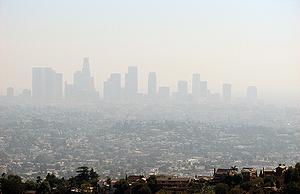根據美國肺臟協會(American Lung Association ) 第10屆年度報告《空氣現況》指出,共1億861萬美國人,即每10人中就有6人,居住在空氣污染危及生命的地區。這些空氣污染主要源自發電廠、柴油引擎和油輪,也是惡化全球暖化之因。

煙霧瀰漫的洛杉磯。攝影:Ben Amstutz
這份報告依影響都市與城鎮的前三大污染類型:臭氧、經年微粒污染與24小時微粒污染來列級,共分為A至F級,發現幾乎每個主要都市都在不健康的標準附近,威脅居民的呼吸能力並危及生命安全。
臭氧污染前三大的都市都在加州:洛杉磯-長堤市-河濱大都會區、聖華金谷區(San Joaquin Valley)的農業暨石油提煉中心貝克斯菲爾市(Bakersfield)及農業社區Visalia-Porterville市。賓州的匹茲堡-新堡市(Pittsburgh-New Castle)被列為24小時微粒污染最嚴重的城市;臭氧污染最嚴重的三個加州城市緊鄰在後,經年粒子污染程度也是前幾名。
臭氧是最普遍的空氣污染形式,吸入臭氧將引起肺臟疼痛發炎,感覺就像是嚴重曬傷。吸入臭氧污染物的健康衝擊十分快速,臭氧也可能會導致氣喘、咳嗽與哮喘病發,甚至縮減壽命。
2008年3月,即使美國肺臟協會採取合法途徑要求實行完整正式的評檢,美國環保署仍將調整空氣污染標準上限至0.075ppm,比肺臟協會建議的0.060ppm還寬鬆。肺臟協會、各州政府和其他公共衛生與環境團體已再提訴,希望環保署至2013年完成5年計畫評檢前採取0.060ppm的標準。
微粒污染方面,2009空氣污染報告評比了24小時和經年粒子汙染,這些污染包括細微煤灰的有毒混合物、柴油廢氣、化學物質、金屬和懸浮微粒。報告發現,每六個美國人就有一人居住在經年微粒污染威脅健康的區域。新的數據顯示,女性達50歲後將可能特別受空氣汙染威脅,而被迫在工作時吸入廢氣的柴油卡車駕駛和碼頭工作者等,將可能面臨更高的罹患肺癌風險或慢性肺功能障礙疾病。
美國肺臟協會醫療總監Norman Edelman表示:「科學結果是無法動搖的。我們現在知道空氣污染會破壞肺部功能,甚至是對最健康的人。空氣污染惡化哮喘並且是心臟病發的直接肇因。」他也建議居住在微粒污染下的民眾「必須採取行動協助保肺協會與其他組織驅策環保署修改規定,這是每個人都可以做到的,而且這不只影響個人也影響他們的鄰居」。另外他也表示,居民可以採取當地政治行動去改變其他規定,如引擎怠速問題、撤除校園柴油巴士等。
此外,低收入民眾和某些種族族群通常遭受更嚴重的汙染物風險。肺臟協會指出,他們的家通常鄰近工廠和發電機等汙染源或雍塞的高速公路旁,許多人也缺乏醫療照護管道,使他們更易受害。某些種族有更高的機率罹患哮喘或糖尿病等疾病,讓他們在空氣污染下的情況更為惡劣。
美國肺臟協會2009年度報告美國最清淨與空氣污染最嚴重的城市請參見 http://www.stateoftheair.org。
Six out of every 10 Americans - 186.1 million people - live in areas where air pollution endangers lives, according to the 10th annual American Lung Association State of the Air report released today.
Some of the biggest sources of air pollution - dirty power plants, dirty diesel engines and ocean-going vessels - also worsen global warming, the Lung Association says in State of the Air 2009.
State of the Air 2009 includes a national air quality report card that assigns A-F grades to communities across the country and details trends for 900 counties over the past decade.
The report ranks cities and counties most affected by the three most widespread types of pollution - ozone, or smog; annual particle pollution; and 24-hour particle pollution levels.
The report finds that air pollution hovers at unhealthy levels in almost every major city, threatening people's ability to breathe and placing lives at risk.
The three cities most polluted by ozone are all in California - the Los Angeles-Long Beach-Riverside metropolitan area; Bakersfield, a center of agriculture, petroleum extraction and refining, and manufacturing in the San Joaquin Valley; and Visalia-Porterville, a San Joaquin Valley agricultural community.
Pittsburgh-New Castle, Pennsylvania tops the list of cities most polluted by 24 hour fine particle pollution, while the three California cities that top the most polluted ozone list are close behind in this category and also for year-round particle pollution.
Ozone is the most widespread form of air pollution. When inhaled, ozone irritates the lungs, resulting in something like a bad sunburn. The health effects of breathing ozone pollution can be immediate. Ozone can cause wheezing, coughing and asthma attacks. Breathing ozone pollution can even shorten lives.
In March 2008, the EPA adopted a standard of .075 parts per million, ppm, after legal action by the American Lung Association forced the agency to complete a formal review. This standard is not as strict as the standard of .060 ppm recommended by the Lung Association.
The association, along with states, public health and environmental groups, has taken the EPA back to court in an attempt to force the agency to adopt the .060 ppm standard before its scheduled five-year review in 2013.
State of the Air 2009 grades counties for both 24-hour and year-round levels of particle pollution - a toxic mix of microscopic soot, diesel exhaust, chemicals, metals and aerosols.
One in six people in the United States lives in an area with unhealthy year-round levels of fine particle pollution (termed annual average levels).
New data show that women in their 50's may be particularly threatened by air pollution and that diesel truck drivers and dockworkers who are forced to breathe exhaust on the job may face a greater risk of developing lung cancer or chronic obstructive pulmonary disease.
"The science is rock-solid. We now know that air pollution can impair the lung function of even the healthiest people," said Norman Edelman, MD, American Lung Association chief medical officer. "Air pollution worsens asthma and is a direct cause of heart attacks, which makes people living with lung and heart disease especially vulnerable."
In addition, Dr. Edelman suggests, people who live with particle pollution "must take action help us and other organizations to change the EPA regulations. It's personal, it's affecting them and their neighbors." In addition, he said, they can take local political action to change regulations such as engine idling, and clean up diesel-powered school buses.
Low income people and some racial and ethnic groups often face greater risk from pollutants. Pollution sources like factories and power plants may be closer to their homes, the Lung Association points out. Many live near areas with heavy highway traffic or have poor access to health care, which makes them even more vulnerable. Some racial and ethnic groups have a higher prevalence of diseases like asthma or diabetes, which compounds the ill effects of air pollution for these groups.

